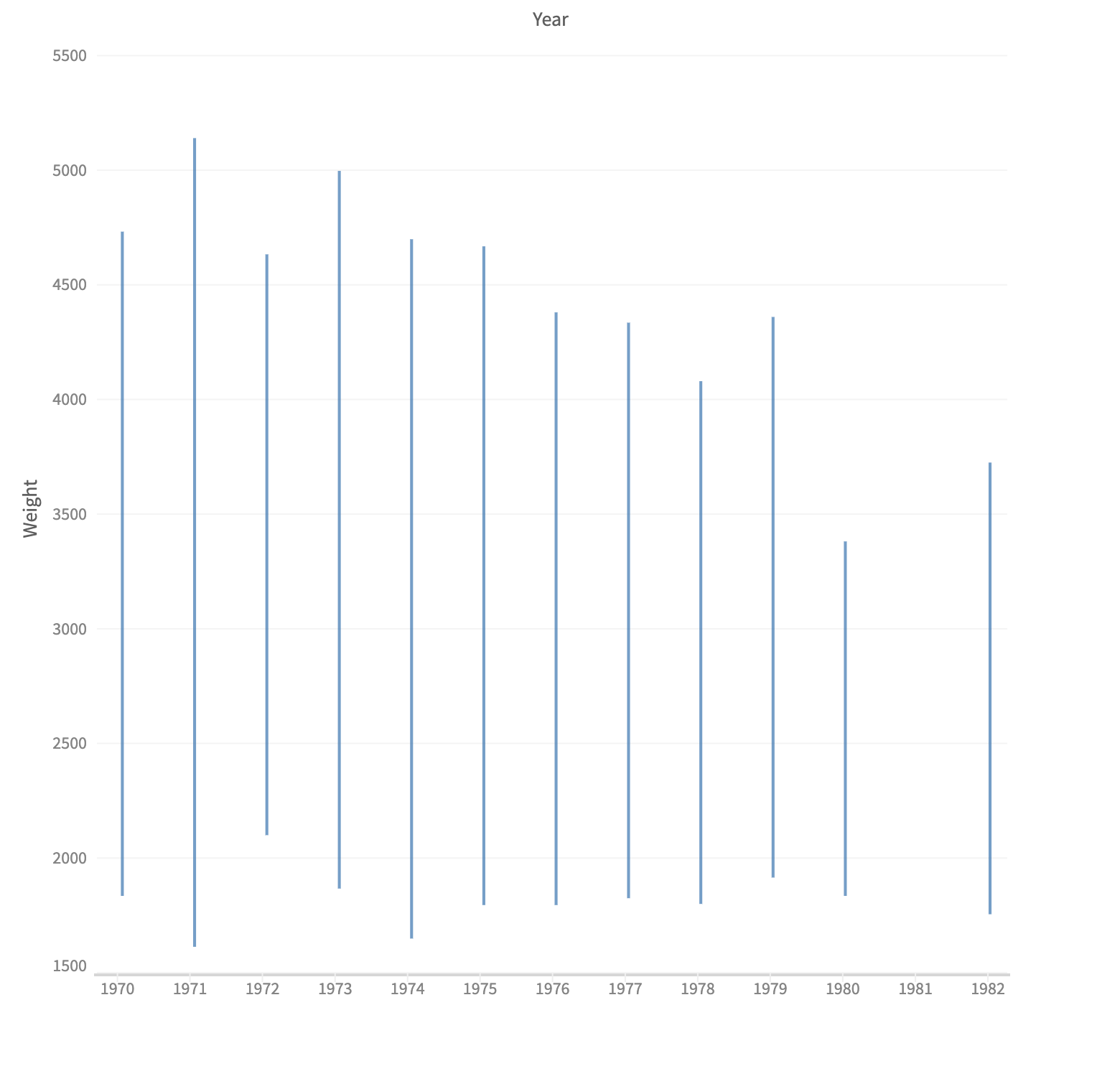Creating range plot
What is a range plot?
Range plots show exactly two dots on a line and connect them. These are great if you want to draw attention to the distance between the values more than to the values themselves. For example a comparison between the minimum and maximum temperature over 10 years can be visualized better with a range plot.
Using the share operator
Share operator creates a new composed variable instance from multiple variables. This is required when we need to map multiple fields in a single axis. For example, we want to show minimum temperature and maximum temperature on y-axis, then we have to create a shared field.
Pass fields to plot in the share operator and attach the result in rows/columns of the chart:
const { muze } = viz;
const { share } = muze.Operators;
const MaxTempField = "maxTemp";
const MinTempField = "minTemp";
const DateField = "date";
const sharedField = share(MaxTempField, MinTempField);
muze.canvas().rows([sharedField]).columns([DateField]).mount("#chart");
Example
Muze's box plot sample uses a shared field in rows.
const { muze } = viz;
const data = [
{
Maker: "BMW",
min: 3000,
q1: 4000,
median: 4800,
q3: 5200,
max: 5800,
},
{
Maker: "Chevrolet",
min: 2800,
q1: 3500,
median: 4200,
q3: 4700,
max: 5200,
},
{
Maker: "Dodge",
min: 3100,
q1: 3900,
median: 5000,
q3: 5500,
max: 6000,
},
{
Maker: "Ford",
min: 2700,
q1: 3400,
median: 3900,
q3: 4400,
max: 5000,
},
{
Maker: "Peugeot",
min: 2500,
q1: 3000,
median: 3100,
q3: 3400,
max: 3700,
},
{
Maker: "Volvo",
min: 2900,
q1: 3300,
median: 3600,
q3: 4000,
max: 4400,
},
{
Maker: "Toyota",
min: 2600,
q1: 3700,
median: 4500,
q3: 4900,
max: 5300,
},
{
Maker: "Honda",
min: 2400,
q1: 3200,
median: 4000,
q3: 4300,
max: 4700,
},
{
Maker: "Nissan",
min: 2500,
q1: 3000,
median: 3800,
q3: 4200,
max: 4600,
},
{
Maker: "Mercedes-Benz",
min: 3400,
q1: 4500,
median: 5200,
q3: 5700,
max: 6100,
},
{
Maker: "Audi",
min: 2900,
q1: 3600,
median: 4100,
q3: 4600,
max: 5100,
},
];
const schema = [
{
name: "Maker",
type: "dimension",
},
{
name: "min",
type: "measure",
},
{
name: "q1",
type: "measure",
},
{
name: "median",
type: "measure",
},
{
name: "q3",
type: "measure",
},
{
name: "max",
type: "measure",
},
];
let dm = new muze.DataModel(muze.DataModel.loadDataSync(data, schema));
const MakerField = "Maker";
const MinField = "min";
const MaxField = "max";
const Q1Field = "q1";
const MedianField = "median";
const Q3Field = "q3";
const DistributionLabel = "Horsepower Distribution";
muze
.canvas()
.rows([muze.Operators.share(MinField, MaxField, Q1Field, MedianField, Q3Field)])
.columns([MakerField])
.layers([
{
mark: "bar",
encoding: {
y: Q3Field,
y0: MedianField,
color: MakerField,
},
},
{
mark: "bar",
encoding: {
y: MedianField,
y0: Q1Field,
color: MakerField,
},
},
{
mark: "tick",
encoding: {
y: Q1Field,
y0: MinField,
color: {
value: () => "black",
},
},
},
{
mark: "tick",
encoding: {
y: MedianField,
color: {
value: () => "#fff",
},
},
},
{
mark: "tick",
encoding: {
y: MaxField,
y0: Q3Field,
color: {
value: () => "black",
},
},
},
])
.config({
axes: {
y: {
name: DistributionLabel,
},
},
})
.title("Box Plot", { position: "top", align: "center" })
.data(dm)
.width(800)
.height(800)
.mount("#chart");

Using encoding channels to define a range plot
Each layer has an encoding object configuration which accepts x0, x, y0, y and color parameters.
To create a vertical range plot, map fields to y0 and y. To create a horizontal range plot, map fields to x0 and x. Optionally, also pass a function in color.value to color the layer plots.
Example
const { muze, getDataFromSearchQuery } = viz;
const data = getDataFromSearchQuery();
const share = muze.Operators.share;
const WeightField = "Weight_in_lbs";
const MinWeightField = "Min Weight";
const MaxWeightField = "Max Weight";
const YearField = "Year";
// Min value of weight for a group
dm = data.calculateVariable(
{
name: MinWeightField,
type: "measure",
defAggFn: "min",
},
[WeightField],
(val) => val,
);
// Max value of weight for a group
dm = dm.calculateVariable(
{
name: MaxWeightField,
type: "measure",
defAggFn: "max",
},
[WeightField],
(val) => val,
);
muze
.canvas()
.rows([share(MaxWeightField, MinWeightField)])
.columns([YearField])
.layers([
{
mark: "tick",
encoding: {
y: MaxWeightField,
y0: MinWeightField,
size: {
value: () => 0.001,
},
},
interpolate: "catmullRom",
},
])
.config({
axes: {
y: {
name: "Weight",
},
},
})
.data(dm)
.width(700)
.height(700)
.mount("#chart");
